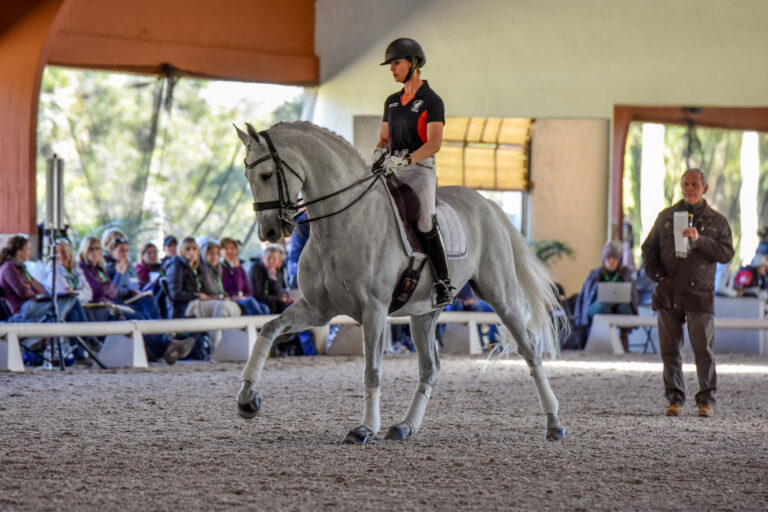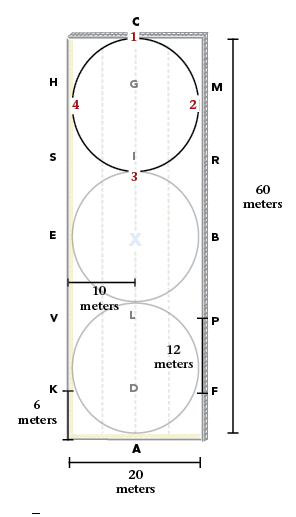“Dressage is the systematic development of the natural abilities of the horse,” stated Henk van Bergen during the first ride of the Adequan®/USDF FEI-Level Trainers Conference. After a two-year absence due to the pandemic, more than 300 enthusiastic individuals descended upon Mary Anne McPhail’s High Meadow Farm in Loxahatchee, Florida, in January to gain wisdom and perspective from van Bergen, David Hunt, Linda Zang and Lilo Fore. They were not disappointed.
The rider and horse combinations were all upper level as the intended purpose of the two-day conference was designed to educate FEI-level trainers and instructors in the classical system of dressage. Throughout the two days, the experts offered numerous training exercises and tips that, while advanced for those in attendance, will offer insights for other levels.
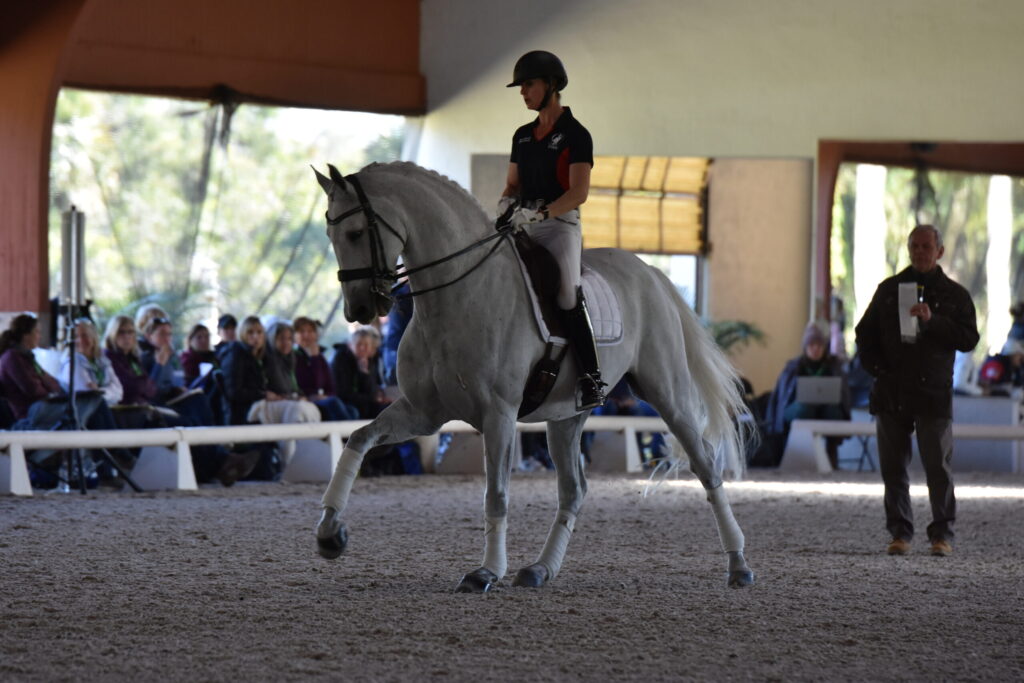
Relaxing a Nervous Horse
Endel Ots rode the talented stallion King’s Pleasure who was nervous in the crowded environment. Hunt emphasized keeping the trot slower than what the horse wanted to do to help him relax. He explained that the rider first needs to teach the horse where he wants him to go. Then secondly, he needs to show the horse how he should go. In this instance, the horse should not be the one to control the pace. The rider should. But at the same time, the horse needs to allow the rider to take him around the arena without it being a big deal.
Hunt then recommended moving a nervous horse sideways because it gives him a job to do and helps expel excess energy. For example, when changing direction across the diagonal, instead of just trotting the diagonal line, leg-yield across the diagonal being sure to keep the horse’s body parallel to the long side of the arena. “If a horse is crossing his legs, he can’t run away from you,” Hunt said. However, while the leg-yield might slow down the horse, it is important to keep the same tempo when trotting straight ahead and not let the horse get quick again.
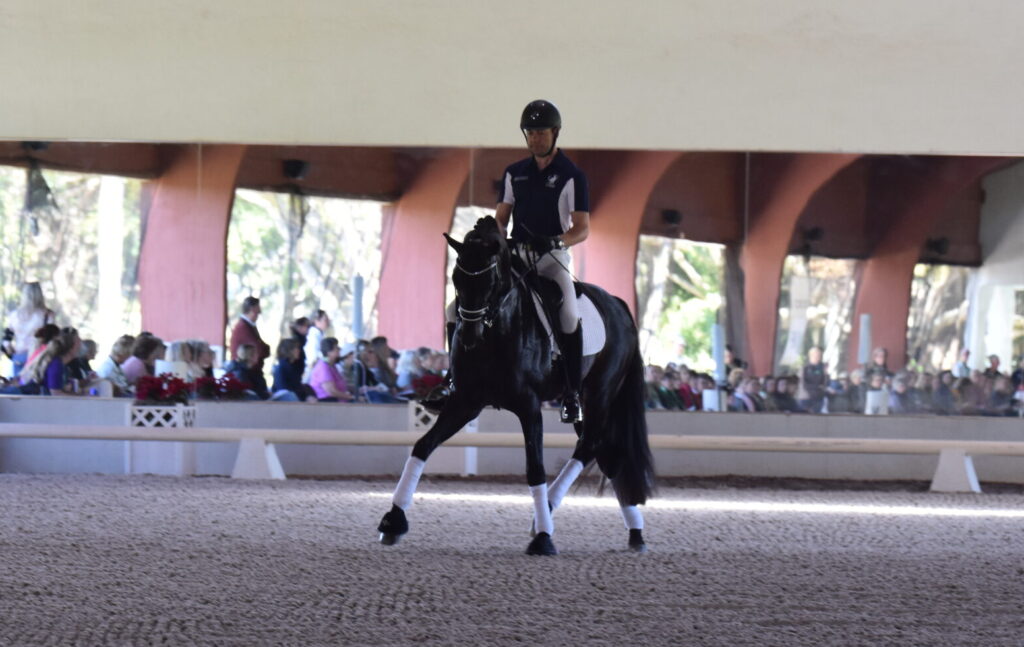
Six-Loop Serpentine
Chris Hickey and Valentin also rode with Hunt the first day. In the canter work, Hunt had Hickey do a challenging exercise of a six-loop serpentine in canter with a flying change each time he crossed over centerline. Hunt stated that “it’s all about the turn,” which must be balanced so the horse can straighten before centerline for a clean change.
Keeping the same canter throughout the exercise is also vital. The horse should not get stronger before or after the change. Hunt admitted it’s a fine line to keep the horse in front of the leg without him getting too strong. Likewise, containing the horse without holding too much. A common mistake riders make is they are so relieved their horses did the change that they let them go after the change, and they get quick. “The easier the canter is, the easier the change will be,” Hunt said.
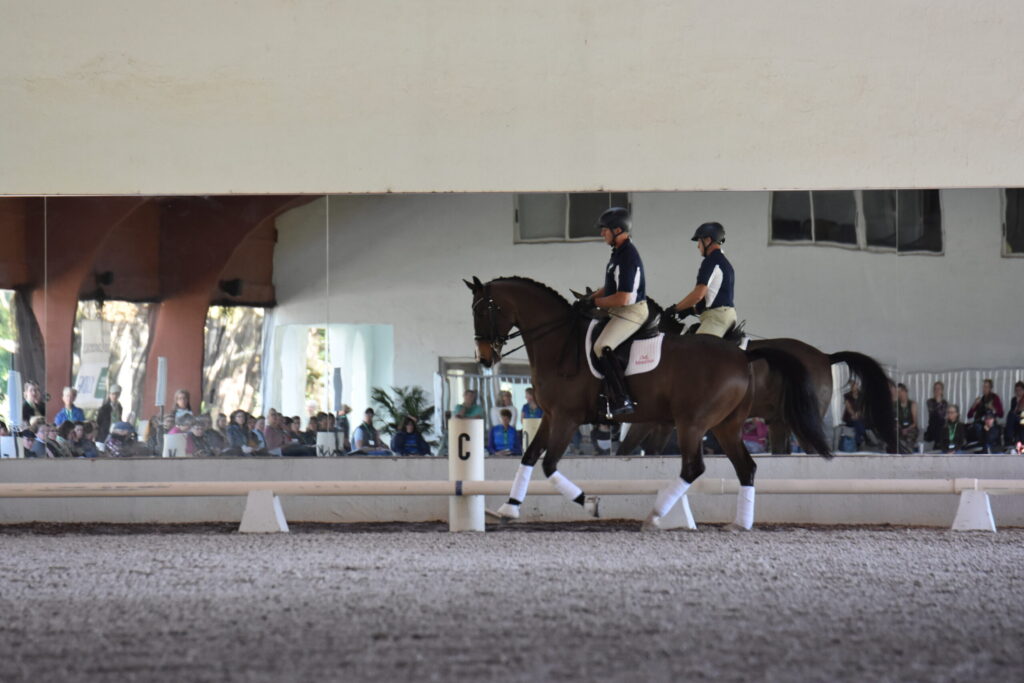
Building Suppleness and Responsiveness
On the second day, van Bergen worked with Cindi Wylie and the PRE stallion Amado XXXV. Instead of asking her to ride shoulder-in down the entire long side, which van Bergen doesn’t like because it goes on for too long, he had Wylie track left. She did the movement out of the corner and then onto a short diagonal line toward B or E. At centerline, she immediately rode a 10-meter half-circle to the right. Then she rode shoulder-in to the right once they returned to the long side in the opposite direction. Then they could do the same exercise to the right on the next long side.
Done correctly, this exercise shows that the shoulder-in is true and that the horse isn’t falling over the outside shoulder. It is important that all the movements be done in the same rhythm. It also needs both horse and rider to think. And finally it requires rider control over the horse’s shoulders and doesn’t allow the horse to take over.
Focus on a Single Flying Change
When the horse anticipates the flying change, doing one or a line of changes, can be challenging on the long diagonal. To help make the horse wait, van Bergen asked Wylie to canter to the left. They rode a short diagonal and did a single flying change. Then at the letter B, she turned onto the opposite short diagonal on the right lead. She rode collected canter to make the horse wait. And then asked for another single change and cantered on the left lead around the short side.
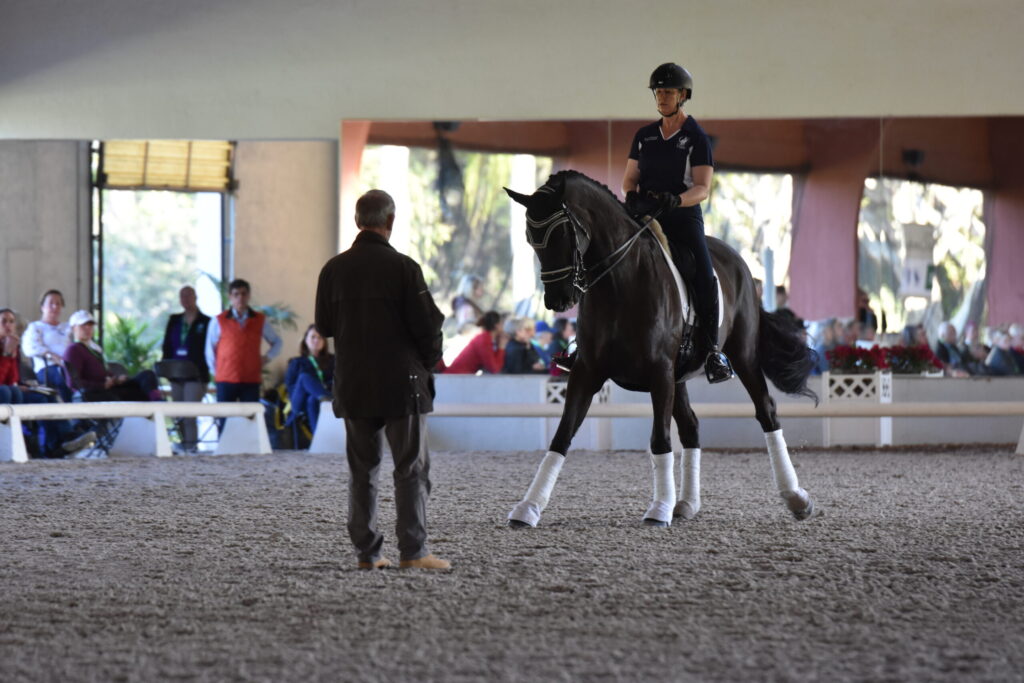
Tension in the Walk
During breaks between riders, Lilo Fore and Linda Zang answered questions submitted from the auditors for help on more training issues. Fore addressed the question, “How do you work on a prompt canter transition from the walk when the horse gets tense in the walk?”
Fore explained that the solution involves the rider’s leg aids. “It is a rider’s tendency to remove legs when a horse is tense. It is not easy to make a rider understand that a feeling, gentle working leg on horse’s body, like you are patting him lightly with your hand. This gives a horse confidence rather than a negative reaction as he knows rider is there for him/her. Legs must be with a horse to truly train him well, How much leg depends a little on the horse.”
She continued by saying that “tension in walk is most times mental tension. If rider stays calm, quietly aiding, making sure that seat, leg and rein aids coincide with each other horse will stay relaxed.” She also stated that the walk is the most difficult gait to keep relaxation. Some riders even feel that working in the walk harms the gait, but she thinks the opposite. “We are working the horse for 20 minutes in trot, for 20 minutes in canter and maybe a few minutes in walk if that much. We should not hesitate to also educate the walk with exercises, transitions etc.”
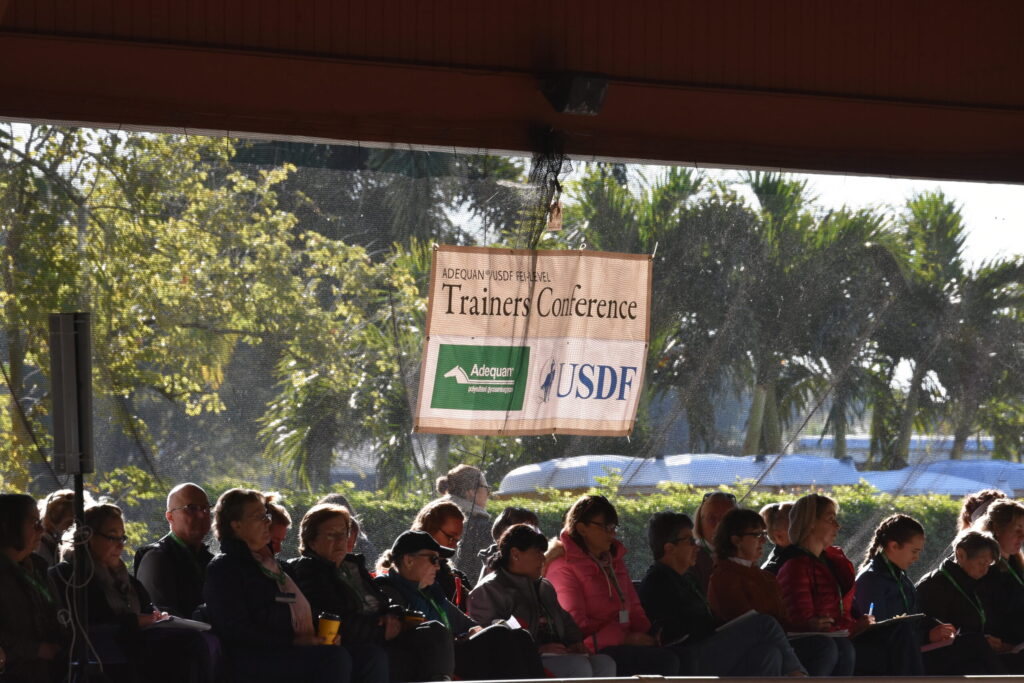
Canter-Walk Transitions
“Canter to walk back to canter cannot be well performed if one has not trained shortening, lengthening, shortening before they are attempted,” Fore continued. “Most horses cannot regulate two gears down without jogging, becoming unbalanced or crashing into the down transition. That is what causes tension. The horse cannot perform this transition in balance as reins become the main aids to stop the horse. That creates an awkward transition. Then tension is the result.”
“It is the rider’s responsibility to learn how to use seat, leg and rein responses and coordinate them to collect the horse as much as possible without letting the canter become tense and short,” Fore said. “The reins become less and less needed as the horse learns to regulate its strides with the educated seat of the rider, and not the reins, as the main cue. Then tension will not become an issue, and the walk after the canter will have not much problem.”

The Purpose of Leg-Yield
Zang expanded on the reason to do leg-yield off both reins and in both directions. “The purpose of the leg-yield is encouraging the [horse’s] inside hind leg to move up under its body toward his outside front leg. The leg-yield is a suppling exercise that encourages the development of lateral responsiveness and strength,” she said.
“I think when you turn to the right or turn to the left, you want them to be able to pick up their inside shoulder and move to the point of balance, which is the outside shoulder. I say that continually. You must have a point of balance, and that would be the outside rein, the horse’s outside shoulder, and as it develops, the outside of the rider rides the horse, encouraging him to stay uphill to the outside rein so he can carry himself instead of being low and down on the forehand.”
This has been confirmed with highly respected veterinarian, researcher and horsewoman Hilary Clayton, BVMS, PhD, Dipl. ACVSMR, FRCVS, who has explained and shown “us to develop the horse’s ability to step under the body with the inside hind to the outside rein, and he opens up the chest and develop the sling muscles.” (These are the main muscles between the horse’s front legs that support the forehand.)
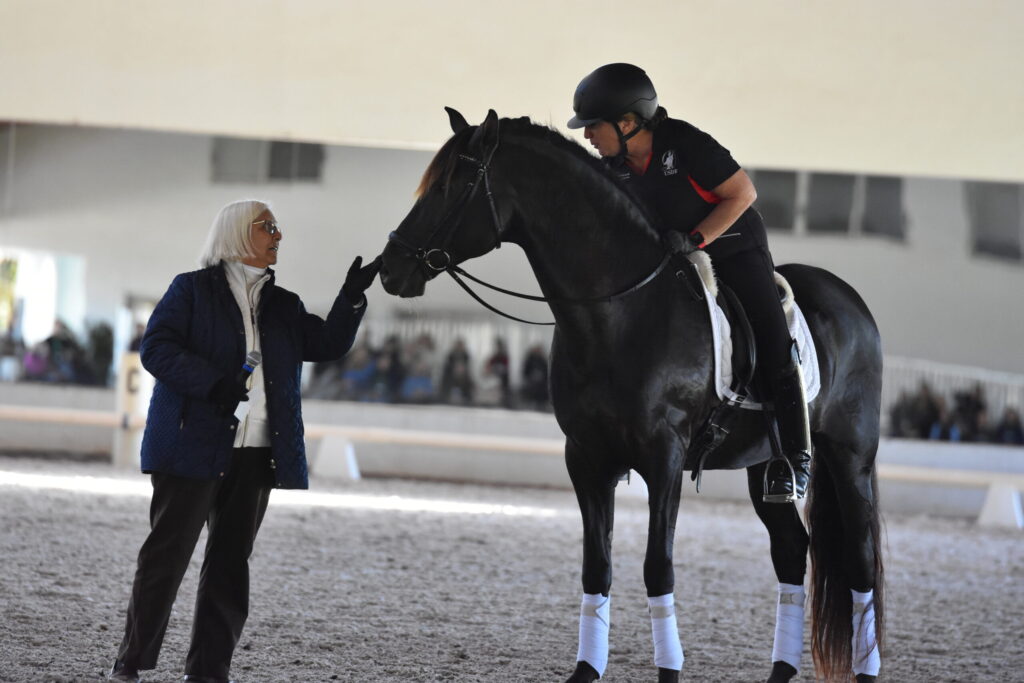
Meet the Experts of the USDF Trainers Symposium
Four members of the FEI Judge Supervisory Panel (JSP) provided instruction and insight at the Adequan®/USDF Trainers Conference. They were:
Lilo Fore – Retired FEI 5* Dressage and Young Horse Judge and 3* PARA Judge, member of Roemer Foundation/USDF Hall of Fame
David Hunt – Chair of the JSP, president of the International Dressage Trainers Club and President of British Dressage
Henk van Bergen – Dutch Master Trainer, coach of multiple Olympic dressage teams
Linda Zang – Retired FEI 5* Dressage Judge, member of Roemer Foundation/USDF Hall of Fame and recipient of the U.S. Congressional Gold Medal of Achievement.
This article originally appeared in the Spring 2023 issue of Practical Horseman. Videos of the sessions can be found on Dressage Today OnDemand.





